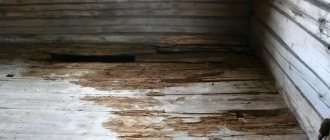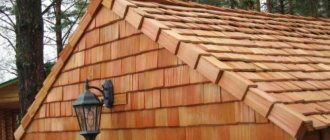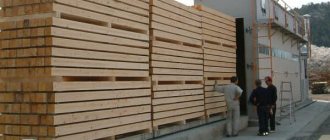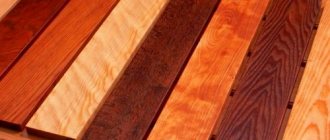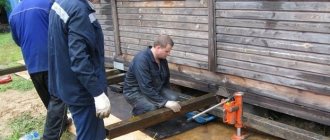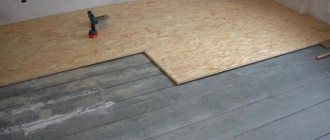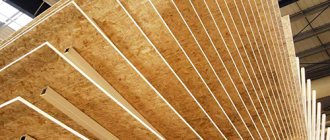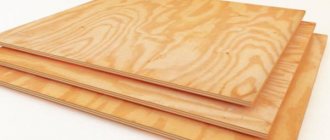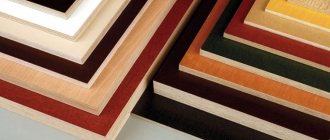Types and features of linoleum for laying on plywood
There are three main types of linoleum - household, commercial and semi-commercial. Each of them is recommended for use in certain rooms. When choosing, you should take into account operational loads, moisture levels, purpose of the room and the base.
Correct installation of linoleum on plywood guarantees a smooth and neat floor covering
Domestic
This material is made on a polyester base. The thickness of one strip is 1-4 mm. The material has a complex structure, and its advantages include:
- wide selection of colors and patterns;
- softness and comfort;
- good moisture resistance;
- affordable price;
- ease of installation.
Despite the obvious advantages of using household linoleum, it also has some disadvantages. The main one is the loss of performance under prolonged loads, so the material does not last long. In addition, due to its soft texture, it leaves dents. Used for residential premises only.
Commercial
This option is recommended for use in offices and other premises with a fairly high operating load. It is characterized by high wear resistance and long service life. When used in showrooms, emblems or other images may be applied to the material. Commercial linoleum can be of homogeneous or heterogeneous type.
The first option has a thickness of 1.5-3 mm. A monochromatic design is applied to it. The composition includes talc, kaolin, limestone. A protective polyurethane coating is applied to the surface. The coating periodically needs sanding.
The second version of the material is versatile and has a multilayer structure. Made from fiberglass. The inner side is lined with fabric, polyvinyl chloride or jute.
Semi-commercial
The material resembles household-type linoleum, but has a denser structure and a high thickness of the protective layer. Used in public and walk-through areas. It is divided into natural and synthetic materials.
Natural material is safe and environmentally friendly. In addition, it is abrasion resistant. For protection, a polymer coating is applied to it. The synthetic type has moisture resistance and excellent sound insulation properties. However, it is not recommended for residential use.
Preparing the “base”
Your initial action should be the correct choice of the wood-laminated material itself.
Plywood selection
The main condition for purchase is sufficient sheet thickness:
- If the coating is created on a board or concrete base, products with a thickness of 0.8-1 cm will be sufficient.
- For wooden floors on joists, more solid products measuring 1.5-2 cm are needed.
- Before use, dry the plywood, soak it with a wood antiseptic and a moisture-proofing compound.
So you need to prepare the foundation.
The stages of laying plywood on a plank base are as follows:
- Attach loose floorboards to the joists with screws or nails.
- If necessary, remove deformed or severely damaged boards and level the joists with wooden wedges.
- Replace damaged floorboards with new ones. When the damage is minor, you can turn the boards over to the other side and nail them to the joists again.
- Recess the protruding fastener heads into the thickness of the floor by 3-4 mm. Sand the knots with a sanding machine or grinder.
The photo shows the flooring of plywood cuts.
Now you can lay down the plywood and fasten it with self-tapping screws.
In order for the coating to be of high quality, the slabs must be laid with your own hands as follows:
- Even if the area of the room allows such an opportunity, it is highly undesirable to lay out entire sheets. In this case, they will be more susceptible to humidity and temperature deformations. Based on this, it is best to cut the products into 2-4 parts.
- The cuts should be laid offset. This means that at a particular point the two joining seams should not coincide.
READ MORE: Connecting strip for linoleum
Preparing to lay linoleum on plywood
Before laying linoleum on plywood, you should pay close attention to the base of the floor. It is necessary to take care of the quality of the floor surface, paying attention to the presence of joints and cracks, sealing them even before installing the linoleum.
Before starting work, it is recommended to let the material lie for several days in the room in which it will be installed. This will allow them to acclimatize. This will help the material lie as smoothly as possible, avoiding the appearance of defects and dents. It is better not to trim the edges of the material before installing the skirting boards.
Preparing plywood for installation
When laying the floor, it is important not only to choose the right linoleum and methods of its installation, but also to pay attention to the installation of the plywood base. If fastened incorrectly, it will ultimately be impossible to achieve the required quality of coating.
Installation of plywood in a checkerboard pattern
To ensure high quality flooring, plywood sheets must be pre-installed using various installation methods:
- Even in a large room, you should not lay the entire sheet of plywood on the floor. Large slabs are more susceptible to deformation, so it is recommended to divide large slabs into several parts.
- It is recommended to lay the pieces of plywood in a checkerboard pattern. In this case, you need to strive to ensure that there are no more than two seams at one point. This minimizes the risk of the base moving during operation.
- It is necessary to ensure that the gap between the plates is no more than 0.5-1 cm. This will help reduce the risk of deformation of the linoleum.
And only after proper installation of a high-quality base can you begin to lay linoleum on plywood.
Preparing material and tools
The optimal temperature for working with linoleum is 15-25 degrees. At low temperatures, it loses its elastic properties and becomes brittle and can easily crack. Therefore, linoleum should lie in a roll indoors, get used to the temperature, and only then can it be unrolled.
Having unrolled the linoleum on the floor, it should again be left alone for several hours. This will help it level out and there will be no waviness when laying.
The following tools are used for work:
- Sharp knife;
- Notched glue spatula;
- Ruler;
- Double-sided tape;
- Glue;
- Roller or brush.
Features of plywood laying
First, you should check the base for defects, and if there are any, eliminate them. After which you can begin to take the necessary measurements, purchase materials and prepare tools. To work, you will need plywood, linoleum of a certain density, baseboards, construction adhesive, screws, and dowels.
If necessary, the old coating is dismantled. Work should be carried out carefully so as not to damage the base. After which its surface is cleaned of dust and debris. If necessary, it is necessary to pour a concrete screed, which guarantees a perfectly flat and smooth surface.
Laying plywood
Then you should proceed to laying the plywood:
- Sheets should be cut based on pre-made measurements.
- First, a layer of waterproofing material must be placed on the concrete base.
- The sheets must be laid out on the floor, secured with self-tapping screws or dowels.
- In some cases, it is advisable to install sheets in several layers. In this case, each layer is attached to the previous one using self-tapping screws.
- If depressions and other damage appear on the surface of the plywood, putty should be used to seal them.
After this, you can lay linoleum on plywood, using a convenient method for carrying out installation work.
Wood floor inspection
Inspecting the wood flooring for damage
Before laying linoleum on a wooden floor, it is necessary to properly prepare the base, since the quality of installation and the service life of the coating directly depend on this. The work begins with an initial inspection and analysis of the condition of the boards. To do this you need:
- Check that each board is securely fastened at all points. Check for any deflections or play in the web;
- Inspect for damage in the form of rotten areas or partial darkening of the board as a result of exposure to moisture;
- Make sure there are no fungal growths or mold, as well as the absence of rusty fastening elements;
- Check if there is a squeak when walking on the floor. If creaking occurs, then the cracks between the boards can be sprinkled with ordinary talcum powder or graphite powder.
Features of installing linoleum
After completing the installation of plywood and checking the finished base for quality, you can proceed to installing the finishing coating. There are two ways to glue linoleum to plywood. The first involves using construction adhesive, and the second involves securing the edges with skirting boards.
Installation without glue
Using glue when installing linoleum in a small room is impractical. In addition, installation without glue is faster and does not require special construction skills. Main stages of work:
- Roll out the linoleum and let it rest. This will not only help it smooth out, but will also allow the materials to acclimate.
- Cut a piece of the desired size, leaving a few centimeters of margin on each side. The material should overlap the walls.
- The material should be leveled starting from the center of the room.
- Trim off excess material on each side using a paint knife.
Removing excess material
- Secure the linoleum around the perimeter using skirting boards. When installing linoleum in walk-through rooms, the joints should be protected with a metal strip.
Laying linoleum on plywood using this method is incredibly simple, so it is recommended to use it for small domestic premises.
You can learn more about gluing linoleum onto plywood from the video:
Fixing the material with glue
Fixing linoleum with glue is a more complex but effective installation method. It guarantees a high level of strength and reliability of the floor covering. Recommended for large rooms.
Installation technology:
- Preparation for installation of linoleum is no different from the previous method. It is necessary to cut the material to the required size and lay out the canvas.
- It is necessary to bend half of the canvas, coat the plywood with glue, and then distribute the adhesive using a spatula or a special grater.
- Place the bent part of the linoleum on the plywood and press it tightly against the plywood.
- Repeat the steps for the second part of the material.
- Roll over the surface with a heavy roller to remove any air bubbles.
This installation method guarantees high adhesion strength of the material to the base and a long service life even in high traffic areas.
How to glue the edge?
The appearance of the coating can be spoiled by poorly glued edges and joint seams.
Bustilate is used for seams. Even if boostilate gets on the front side, it will not spoil the coating, since the composition is transparent and not noticeable. To glue the edge of the linoleum, you need to bend it back and apply bustilate to the floor. Press the edge so that there are no air bubbles underneath. It is advisable to leave the load on top until it dries. Then you need to attach the plinth or threshold strip.
To fix joints, reaction types of adhesive joints are used - they differ from the main adhesive composition. Cold welding seals the seam. One tube is enough for up to 20 linear meters.
The technology is simple - masking tape is attached to the joint, cut along the seam, and using a nozzle, the glue is squeezed out over the entire joint. After hardening, the strip of tape with any remaining liquid is removed.
Tips for laying linoleum on plywood
To get excellent results when installing linoleum on plywood sheets, you need to listen to the recommendations of experienced craftsmen:
- after purchase, the material must acclimatize;
- It is better not to walk on the new surface for several days;
- after installation is completed, it is necessary to trim the edges in places near the walls and the opening, not forgetting that the material may shrink;
- in the doorway, it is better to fasten the material with double-sided construction tape;
- It is better to fasten the seams using the cold welding method.
Laying linoleum on plywood sheets guarantees a perfectly even coating with minimal risk of the formation of depressions and other defects. In addition, the plywood layer provides additional heat and sound insulation.
